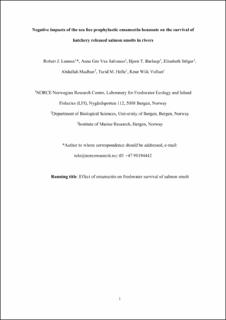| dc.contributor.author | Lennox, Robert J. | |
| dc.contributor.author | Salvanes, Anne Gro Vea | |
| dc.contributor.author | Barlaup, Bjørn Torgeir | |
| dc.contributor.author | Stöger, Elisabeth | |
| dc.contributor.author | Madhun, Abdullah | |
| dc.contributor.author | Helle, Turid Myklebust | |
| dc.contributor.author | Vollset, Knut | |
| dc.date.accessioned | 2021-05-10T12:22:54Z | |
| dc.date.available | 2021-05-10T12:22:54Z | |
| dc.date.created | 2020-08-03T13:14:33Z | |
| dc.date.issued | 2020 | |
| dc.Published | Aquatic Toxicology. 2020, 224 1-8. | |
| dc.identifier.issn | 0166-445X | |
| dc.identifier.uri | https://hdl.handle.net/11250/2754689 | |
| dc.description.abstract | Emamectin benzoate (EB) is a prophylactic pharmaceutical used to protect Atlantic salmon (Salmo salar) smolts migrating out of rivers and into the ocean against sea lice parasites. Randomized control trials comparing the marine survival of smolts treated with EB to a control group is used to calculate the fraction of marine mortality attributable to sea lice parasitism. However, it is assumed that there is no baseline difference in survival induced by the application of EB treatment. We used a combined laboratory and field study approach to investigate the potential impacts of EB treatment on behaviour and survival of hatchery-reared Atlantic salmon in western Norway. In aquaria experiments, EB-treated salmon smolts did not differ significantly in exploratory behaviour. Fish from treated groups responded similarly to simulated predator attack with spontaneous escape and elevated gill beat rate. Three rivers in the Osterfjord system of western Norway were selected for field experiments, Dale, Vosso, and Modalen. Dale River smolts were treated with intraperitoneal EB injections and had lower probability of detection in a wolf trap downstream of the release site than control smolts. Salmon smolts raised in the Vosso River hatchery were treated with EB delivered in their food and were detected on PIT antennas at the rivermouth of Vosso and Modalen at lower rates than control fish, but only when released at downstream sites. Calculation of risk ratios suggested that the bias in mortality caused by treatment with EB decreased the estimated survival of treated fish from an expected 18%to 46%, reducing the observable negative impact of sea lice on Atlantic salmon smolts in randomized control trials. The results suggest that estimates of the fraction of mortality attributable to sea lice may be underestimated due to lower baseline survival of treated fish caused by treatment and bring urgent attention towards a potential systematic underestimation of the impacts of sea lice on wild salmon. | en_US |
| dc.language.iso | eng | en_US |
| dc.publisher | Elsevier | en_US |
| dc.rights | Attribution-NonCommercial-NoDerivatives 4.0 Internasjonal | * |
| dc.rights.uri | http://creativecommons.org/licenses/by-nc-nd/4.0/deed.no | * |
| dc.title | Negative impacts of the sea lice prophylactic emamectin benzoate on the survival of hatchery released salmon smolts in rivers | en_US |
| dc.type | Journal article | en_US |
| dc.type | Peer reviewed | en_US |
| dc.description.version | acceptedVersion | en_US |
| dc.rights.holder | Copyright 2020 Elsevier | en_US |
| dc.source.articlenumber | 105519 | en_US |
| cristin.ispublished | true | |
| cristin.fulltext | postprint | |
| cristin.qualitycode | 2 | |
| dc.identifier.doi | 10.1016/j.aquatox.2020.105519 | |
| dc.identifier.cristin | 1821333 | |
| dc.source.journal | Aquatic Toxicology | en_US |
| dc.identifier.citation | Aquatic Toxicology. 2020, 224, 105519 | en_US |
| dc.source.volume | 224 | en_US |

